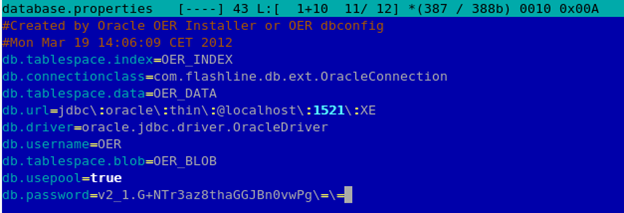[Article based on: http://docs.oracle.com/cd/E10383_01/doc/bip.1013/e11867/T434820T487783.htm]
The following article describes Oracle BI Publisher installation process on a WLS 11g running on a UNIX server.
Components required for the installation can be found in “/manual” subdirectory of the BI Publisher installation folder.
The BI Publisher install media contains:
|
Directory |
Component |
|
manual\fonts |
Font files |
|
manual\generic |
xmlpserver.war (for non-oc4j application servers) |
|
manual\oc4j |
xmlpserver.ear (for oc4j) |
|
manual\XMLP |
XMLP repository |
|
manual\XMLP\DemoFiles |
Data source for demo reports. |
|
manual\XMLP\Tools |
Template Builder for Word Add-in |
Installation steps
-
Create an exploded archive directory.
Example:
/oracle/bipubhome/xmlpserver.war
jar -xvf /<installation_dir>/manual/generic/xmlpserver.war
- In a browser, open the WebLogic Administration console (ex. http://hostname:7001/console).
- If you have not already done so, in the Change Center of the Administration Console, click Lock & Edit.
- In the left pane of the Administration Console, click Deployments.
- In the right pane, click Install

- Select xmlpserver.war directory and click Next
- Select “Install this deployment as an application” and click Next

- Select deployment target

- Select “I will make the deployment accessible from the following location” from Source accessibility.


- Click Finish. To activate these changes, in the Change Center of the Administration Console, click Activate Changes.
-
Copy the XMLP repository directory from \manual on your installation media to your server, ex. /oracle/bipubhome/xmlpserver.war
Note: If you are installing BI Publisher to work with OER, please copy XMLP directory supplied with OER.
-
Open the xmlp-server-config.xml file located in the
<application installation>/WEB-INF/ directory, where your application server unpacked the war or ear file.
Example:
In an AS/OC4J 10.1.3 deployment, the location is <ORACLE_HOME>/j2ee/home/applications/xmlpserver/xmlpserver/WEB-INF/xmlp-server-config.xml
If you are on BI Publisher version 10.1.3.3.1 or later, the file contains the following:
<?xml version="1.0" encoding="UTF-8"?><xmlpConfig xmlns="http://xmlns.oracle.com/oxp/xmlp"><resource><file path="${oracle.home}/xdo/repository"/></resource></xmlpConfig>Note: If you are on version 10.1.3.3 of BI Publisher, the <file path> element will appear as follows:
<file path=”%s_Reports_Path%”/>. Replace the “%s_Reports_Path%” string with the file path to the location where you copied the XMLP repository directory on your server, as described in the next step.

-
Replace ${oracle.home}/xdo/repository with file path to the location where you copied the XMLP repository directory on your server.
For example, if you copied the repository directory to/home/repository/XMLP, update the xmlp-server-config.xml file as follows:
<?xml version="1.0" encoding="UTF-8"?><xmlpConfig xmlns="http://xmlns.oracle.com/oxp/xmlp"><resource><file path="/home/repository/XMLP"/></resource></xmlpConfig>Save xmlp-server-config.xml after updating.

-
Copy the font files from the manual\fonts on the install media to the fonts directory of the Java Runtime Environment used by your J2EE container/application server.
Example for Apache Tomcat:
C:\Program Files\Java\jre1.5.0_07\lib\fonts
Example for Oracle Application Server or OC4J:
<ORACLE_HOME>…\jdk\jre\lib\fonts
Example for WebSphere:
<WebSphere dir>/AppServer/java/jre/lib/font
-
Start the service: click Deployments, then xmlpserver.
Start xmlpserver application.
-
Launch BI Publisher:
Open your browser to http://hostname:port/xmlpserver
For example:
http://localhost:7001/xmlpserver

-
Log in with user name “Administrator” and password “Administrator”.
Important: Default Administrator password can be changed on the Account tab under Preferences.
-
Remark: if you are installing BIP for OER, copy XMLP folder from OER for BIP; look for “reports” folder in OER installation, e.g.: /oracle/fmwhome/repository111/core/tools/solutions/reports
Replace content of XMLP in destination folder, e.g. /oracle/bipubhome/xmlpserver.war.








